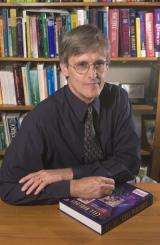Biologists use mathematics to advance our understanding of health and disease

Math-based computer models are a powerful tool for discovering the details of complex living systems. John Tyson, professor of biology at Virginia Tech, is creating such models to discover how cells process information and make decisions.
"Cells receive information in the form of chemical signals, physical attachments to other cells, or radiation damage, for instance," Tyson said. "On the basis of this information, the cells must make the correct response, such as to grow and divide, or to stop growing and repair damage, or to commit suicide."
The question for a molecular biologist is: What are the underlying molecular mechanisms that implement these information processing systems? "Just as computer is an information processing system, with silicon chips, wires, mother board, clock, and power source, a cell is a an information processing system made of genes, messenger RNAs, proteins, and enzymes," Tyson said. "Somehow these molecules interact with each other to detect signals, make decisions, and implement the proper response."
Tyson and other biologists want to know how jumbles of molecules can figure out how a cell should respond to its environment in order to survive, grow, and reproduce. "So we do what any good engineer would do. We create a mathematical model of the components and their interactions, and let the computer work out the details."
Tyson will present his findings at the American Association for the Advancement of Science meeting February 18-22 in San Diego, as part of a session on "Moving Across Scales: Mathematics for Investigating Biological Hierarchies," which includes talks ranging from "HIV interventions in Africa" to the "Neural Dynamics of Decision Making." Tyson will talk about "Molecular Network Dynamics and Cell Physiology," or the cell as an information-processing system.
The speakers in this session will illustrate how math models help scientists reason across scales in biology, such as from interactions between sick and healthy people to the spread of global pandemics. Whereas models of this sort can inform public health decisions on a global scale, Tyson's research addresses basic science at the smallest scale - bridging the gap from molecules to cells. "We have to first understand the molecular basis of normal cell behavior; then we have a chance of figuring out how the system is broken in diseased cells," said Tyson.
"What decision-making processes tell a cell when to grow and divide and when to just hang-out? It is mistakes in this decision process that cause cancer. Tumors are cells growing when and where they shouldn't. Cancer is a collection of diseases caused by faulty decision-making at the cellular level. The cells are no longer obeying the rules. We know the cause is in the molecules that are supposed to be enforcing these rules."
During the course of his research, Tyson and colleagues have used computer simulations to test their math models. "If the math model behaves in the computer the way cells behave in the lab, we gain confidence that we understand the molecular interactions correctly. If not, we can be sure that our models are missing something important."
Tyson will talk about the control of cell division in yeast and in mammalian cells. "Yeast cells are easy to work with in the lab, and their molecular control systems are very similar to the control systems in mammalian cells," he said As a result of the success that Tyson and his colleagues have had in modeling yeast cell growth and division, they are now making the transition to mammalian cells and cancer.
"We do not yet have an engineer's understanding of normal mammalian cell proliferation and of what goes wrong in cancer cells," Tyson said. "Cancer treatment is still a matter of cutting out, blasting, or poisoning cancer cells—and any normal cells that get in the way. We could be more subtle and perhaps more effective in treating cancers if we had a systematic insider's understanding of the molecular networks that control cell growth, division and death, and an ability to manipulate this control system with a new array of drugs and procedures."
Provided by Virginia Tech















